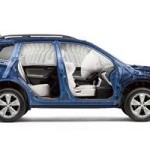
The newer cars are packed with incredible safety equipment to help prevent crashes (note: crashes, not accidents; an accident is an opinion) and save lives when a crash occurs.
All newer cars have great safety equipment. These vehicles come with antilock brakes (ABS), electronic stability control (ESC) and air bags, including curtain air bags (SRS). ABS brakes reduce stopping distance and help to keep the vehicle in control by not allowing the wheels to lock up; ESC helps to keep the vehicle from skidding or sliding. Air bags and curtains help to save lives in the event of an accident. Electronic stability control (ESC) and antilock brakes (ABS) both help to prevent crashes.
The newer vehicles have incredible features to help prevent crashes:
Forward-Collision Warning (FCW): This system lets you know with an audible noise and a warning light that a crash is inevitable. I have this on my 2014 Subaru and it has saved me from a crash at least once.
Automatic Emergency Braking (AEB): This system will put on your brakes for a driver to avoid a crash if the driver is not reacting in time.
The combination of Forward-Collision Warning (FCW) and Automatic Emergency Braking (AEB) has shown a reduction of rear-end collisions by about 50 percent, according to the Insurance Institute for Highway Safety.
Adaptive Cruise Control (ACC): This system, through the use of cameras, lasers and/or radar keeps a safe distance between you and the vehicle in front of you; it applies throttle and brakes as needed. ACC makes driving on freeways safer and reduces driver fatigue.
Blind-Spot Warning (BSW): This system warns you with audio and lights that it is unsafe to charge lanes or merge because a vehicle is next to you. This helps to prevent crashes because of your “blind spot” in rear-view mirror.
Lane-Departure Warning (LDW) and Lane-Keeping Assist (LKA): LDW signals through audio, lights or vibrating the driver’s seat that you are not staying between the lines. On some vehicles, LKA will “pull” your vehicle back into your lane by applying one side of the brakes. Both LDW and LKA are disabled when you use your turn signals. Note: By not using your turn signals to disable these systems, you can wear down your brakes on some vehicles.
Rear Cross-Traffic Warning (RCTW): This system will let you know if an object or vehicle is approaching while you’re backing up; it’s very useful in parking areas.
My 2014 Subaru has forward collision, automatic emergency braking, adaptive cruise control and lane departure warning systems. The chime goes off when I get close or go over a painted line without using my turn signal. I do need to be reminded to always use my turn signal and that I’m getting close to the painted line on the side of the road. The feature that I really like is the chime and message on the info panel that says, “Car in front has moved.” Yes, occasionally at a red light, I’m not paying attention that the traffic has started to move again and that I need to accelerate.
I really like the idea that this system can bring the vehicle to a stop quickly without me even touching the brakes. This system can prevent a crash and injury. In my 44 years of driving, I have never rear-ended a vehicle but it’s nice to know I now have a backup plan.
The adaptive cruise control I’m just OK with. This keeps a safe distance from the vehicle in front of you. In moderate traffic that is changing speeds, this system can accelerate to keep the distance the same as the vehicle in front; it starts to slow, then puts on the brakes as the vehicle in front is starting to speed up. The cruise “oscillates” your speed, speeding up and then applying the brakes. It’s very easy to explain why: the cameras are only watching the vehicle in front of you. Thanks to the ability of the human brain, we scan as far ahead as we can see and will let up off the throttle when we see the vehicles in front start to slow down. It is impossible for this system to anticipate the traffic that is in front of the vehicle that is in front of you. With light traffic, however, this system works very well.
All things considered, these systems work great. The ability to be able to prevent one crash is well worth the price.
Looking well into the future, when vehicles in close proximity can “talk” to each other, these issues won’t be a problem. Even now, the Tesla’s detection systems can look far ahead and stop more quickly, preventing the cruise control from “oscillating.”
While advanced safety equipment adds to the cost of a vehicle, these systems also help to reduce death and injury while you’re driving the vehicle – a very good investment.
George’s driving tips:
1. Always use your seat belt.
2. Check tire pressure at least monthly while tires are cold. Buy a tire pressure gauge to have in your vehicle. Recommended tire pressure is on the driver’s door post.